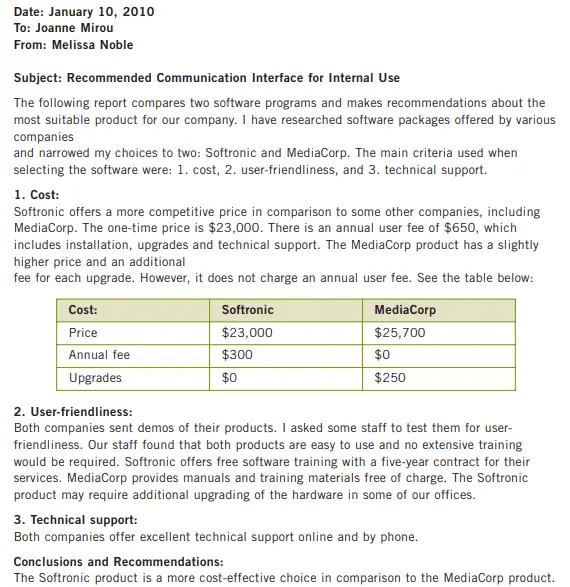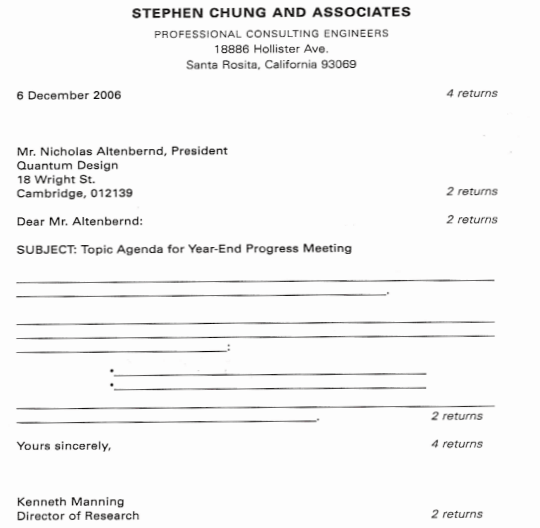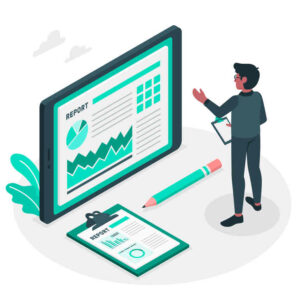Formal reports have long been regarded as the go-to medium for presenting data and findings. However, in today’s corporate environment, informal business reports have emerged as a valuable alternative. These reports are concise, and insightful, and provide a fresh approach to conveying essential information. In this article, we will explore techniques on how to create effective informal business reports to enhance your business communication.
What is an Informal Business Report?
An informal business report is a document that conveys information, data, or findings within an organization in a less structured and more casual manner than a formal business report. It is often used in facilitating internal communication within a company or among team members. Informal reports are generally shorter, more concise, and less rigid in their formatting compared to formal reports.
Key characteristics of an informal business report include:
- Tone: Informal reports use a conversational and less formal tone. They may employ first-person pronouns (e.g., “I,” “we”) and language that is more familiar and approachable.
- Structure: While informal reports still have a basic structure with an introduction, main body, and conclusion, they might not have as many subsections or formal headings as formal reports.
- Audience: The primary audience for informal reports is often individuals within the organization, such as colleagues, supervisors, or subordinates.
- Use of Graphics: Depending on the nature of the report, informal reports might include simple graphics, charts, or tables to support the information presented.
- Conclusion and Recommendations: Informal reports often include a brief conclusion or summary of the key points and may suggest recommendations or actions to be taken.
How to write an Informal Business Report?
Writing an informal business report involves conveying information in a clear and concise manner while maintaining a casual and approachable tone. Below is a detailed step-by-step guide to help you write an effective informal business report:
1/ Understand the Purpose: Before you begin writing, clarify the purpose of the report. Determine what information you want to convey and who the target audience is. Knowing the purpose and audience will help you structure your report appropriately.
2/ Choose a Suitable Format: While informal reports are less structured, it’s essential to choose a format that suits the content and the audience. You can opt for a memo-style format, an email format, or any other informal document format that is commonly used within your organization.
3/ Start with a Friendly Greeting: If you’re writing an email or a memo, start with a friendly greeting, addressing the recipients by name if possible. Such an approach establishes a positive tone for the report.
4/ Start with a Clear Introduction: Begin the report with a concise and clear introduction. State the reason for writing the report, what it aims to address, and any relevant background information. This section should be brief and provide context for the rest of the report.
5/ Present the Main Content: In the main body of the report, present the information or data in a logical and organized manner. Use paragraphs to break down the content into manageable chunks. Consider utilizing headings or bullet points to emphasize key points or separate different sections.
6/ Support with Evidence or Examples: If applicable, provide evidence, data, or examples to support the information you are presenting. This could include charts, graphs, tables, or statistics.
7/ Use Clear and Concise Language: Write in a straightforward and conversational tone. Avoid unnecessary acronyms, or technical terms that may not be familiar to all readers. Ensure your language is easily understandable by your target audience.
8/ Address the “So What?” Factor: As you present information, ask yourself, “So what?” What are the implications of the data or findings? What actions or decisions could be influenced by this information? Answer these questions to provide meaningful context to the report.
9/ Include a Conclusion: Summarize the key points or findings in the conclusion section. Briefly restate the purpose of the report and highlight the main takeaways. You may also suggest potential next steps or actions if applicable.
10/ Offer Recommendations (if applicable): If the report involves analysis or evaluation, you may include recommendations for action. Be confident in your suggestions but also make it clear that they are not mandatory directives.
11/ Add a Friendly Closing: End the report with a friendly and positive closing statement. This could be a sentence expressing your availability for further discussion or questions.
12/ Proofread and Edit: Before finalizing the report, carefully review it for errors in grammar, spelling, and coherence. Ensure that the report flows smoothly and that the message is effectively conveyed.
13/ Distribute Appropriately: Share the report with the intended recipients. If it’s an email or digital document, ensure it reaches the appropriate individuals through the company’s communication channels.
Apart from following the above-mentioned parts of informal business reports, it is important to note that even though these reports are less formal, they still require professionalism and clarity in their content.
Examples of Informal Business Writing

What is informal report writing?
Informal report writing refers to the process of creating documents that convey information, findings, or recommendations in a more relaxed and casual manner compared to formal reports. These reports are typically intended for internal use within an organization or for personal communication.
Here are some key characteristics of informal report:
- Tone: Informal reports use a conversational and friendly tone, often avoiding overly technical language or jargon. The language is more accessible and reader-friendly.
- Structure: While there may be a loose structure, informal reports do not follow strict formatting rules like formal reports. They can vary in length and may include bullet points, lists, or headings for the organization.
- Length: Informal reports are usually shorter in length compared to formal reports, focusing on the main points.
- Audience: These reports are typically intended for a specific audience within the organization, such as a supervisor, colleagues, or team members.
- Recommendations: In an informal report, recommendations may be presented in a more straightforward and informal manner, without the need for detailed justifications.
How to write an informal report?
The format for informal report writing is less structured compared to formal reports, but there are still some key elements that you should include to ensure clarity and coherence. Here’s a typical structure of an informal report:
1/ Title or Heading: Include a clear and informative heading at the beginning of the report. The heading should indicate what the report is about and may include additional information such as the date, the sender’s name, and the recipient’s name.
2/ Introduction: Begin the report by presenting a concise introduction that offers context and distinctly states the report’s purpose. In addition, clearly, mention the reason for writing the report and what the reader can expect to find in it.
3/ Main Points or Sections: Present the main points or sections of the report. You can utilize headings and subheadings to logically organize the content. Make sure that each section centers around a particular aspect or topic that is relevant to the report’s subject matter.
4/ Body of the Report: In the body of the report, provide the necessary information in a clear and concise manner. Employ bullet points or concise paragraphs to effectively communicate the details. Utilize a simple language that the intended audience can easily understand.
5/ Data and Visuals (if applicable): If your report involves data, statistics, or any information that can be better presented visually, include simple charts, graphs, or tables. Visuals can enhance understanding and make the report more engaging.
6/ Recommendations (if applicable): If your report requires action or decision-making, provide clear and concise recommendations. Highlight what steps should be taken based on the information presented.
7/ Summary and Conclusion: After presenting the main points and recommendations, provide a brief summary of the key takeaways. Restate the purpose of the report and any crucial next steps or actions to be taken.
8/ Closing: Conclude the report with a closing statement or thank-you note, depending on the context and relationship with the recipient.
9/ Attachments (if necessary): If there are any supporting documents or additional information related to the report, you can attach them at the end of the report.
10/ Signature (if applicable): If the report is being sent as a formal communication, you can include a signature block with the sender’s name, title, and contact information.
Keep in mind that an informal report allows for a more casual and conversational tone, but it should still maintain clarity and professionalism. Consider the audience when writing the report and use language appropriate for them. Also, remember to proofread and edit the report for clarity and grammar before finalizing it.
Example of an informal reports

7 types of informal reports
Informal reports come in various types, each serving different purposes within an organization. Here are seven common types of informal reports:
1/ Informational Report: An informational report is used to convey facts or information about a particular topic. It presents details without any analysis or interpretation. Informational reports are often used to share updates, status reports, or progress on a project. The structure typically includes an introduction, a main body with key points, and a conclusion.
2/ Progress Report: A progress report tracks the development of a project or task over a specific period. It outlines the achievements, milestones, challenges, and future plans. Progress reports are regularly issued to update supervisors, team members, or stakeholders on the project’s status.
3/ Meeting Report: A meeting report summarizes the discussions, decisions, and action items from a meeting. It highlights important topics, agreements made, and any action points assigned to team members. Meeting reports are helpful to keep all stakeholders informed about what was covered during the meeting and what steps will be taken going forward.
4/ Trip Report: A trip report documents observations, findings, and experiences during a business trip, conference, or site visit. It often includes details about the purpose of the trip, places visited, people met, and any valuable insights gained. Trip reports can be used to inform colleagues, management, or other team members who were not part of the trip.
5/ Incident Report: An incident report is used to document any unusual or unexpected event that occurs in the workplace. It could involve accidents, safety concerns, equipment glitches, or any other incidents that may impact operations or employees. Incident reports should include specific details about the incident, such as the occurrence time, the individuals involved, and any immediate actions taken to resolve the situation.
6/ Informal Survey Report: Informal survey reports present the results of small-scale surveys or feedback collected within the organization. These surveys are often less structured than formal surveys and are used to assess opinions, preferences, or employee satisfaction. The report should include the survey questions, summarized responses, and any conclusions drawn from the data.
7/ Recommendation Report: A recommendation report is used to suggest a course of action or propose solutions to a specific problem or challenge. It involves analyzing the situation, identifying options, and providing well-supported recommendations. The report should present both the merits and demerits of each option and justify why a particular recommendation is preferred.
Related Reading: 24 Types of Business Reports With Samples & Writing Structure
Difference between Formal and Informal Business Reports
Aspect | Formal Business Reports | Informal Business Reports |
Purpose | To present detailed, structured information for decision-making, planning, or compliance purposes. | To share brief, casual information within the organization for updates, discussions, or internal communication. |
Format and Structure | Follows a structured business report format with sections such as title page, table of contents, executive summary, introduction, body, conclusion, recommendations, and appendices. | Less structured with fewer sections, typically comprising a title, introduction, main body, and conclusion. It may have attachments but is not as rigidly organized as formal reports. |
Language and Tone | Employs a more formal and professional language, avoiding jargon, slang, or colloquial expressions. The tone is objective and impersonal. | Uses a more conversational and casual language suitable for the intended audience. The tone can be relaxed, friendly, or even humorous, depending on the context. |
Audience | Often prepared for higher-level management, executives, clients, or external stakeholders. | Primarily intended for internal audiences, such as team members, colleagues, or immediate supervisors. |
Length | Typically longer due to the comprehensive nature of information and supporting data. | Tends to be a shorter report as it focuses on providing essential information without extensive elaboration. |
Frequency | Usually prepared on a scheduled or periodic basis (e.g., monthly, quarterly, annually). | Created as the need arises and might be a one-time report or shared informally as updates occur. |
Related Reading: Difference between formal and informal report writing
What is the purpose of an Informal Report?
An informal report is used to communicate reliable information rapidly and concisely to the internal members of an organization. It pertains to the day-to-day decisions that arise consistently in a business.
Informal report writing is a crucial form of business communication as it allows the company to manage operational tasks and take swift decisions effectively.
The purpose of an informal report is to report short pieces of information in a clear and understandable way. The writer is not required to get into extensive background research and detailed information.
This makes an informal report an effective guide for undertaking routine activities and developing operational strategies.
Related reading: Importance of Business Report
Informal Report topics that you can use
8 informal report topics that could be relevant and useful within an organization:
1/ Employee Engagement Survey Results: Summarize the findings of an informal survey on employee engagement levels within the organization.
2/ Team Building Workshop Feedback: Provide a report on the outcomes and feedback from a recent team-building workshop.
3/ Customer Feedback Analysis: Analyze customer feedback received through informal channels like social media or direct interactions with customers.
4/ Remote Work Productivity Insights: Share insights on employee productivity and challenges observed during a trial period of remote work.
5/ New Product Ideas from Employee Brainstorming: Summarize the creative product ideas generated during an informal brainstorming session.
6/ Informal Market Research on Competitors: Report on informal research findings related to competitors’ strategies and offerings.
7/ Client Meeting Takeaways: Summarize key takeaways and action items from an informal meeting with a potential or existing client.
8/ Informal Assessment of Training Workshop: Evaluate the effectiveness of a recent training workshop based on informal feedback from attendees.
Frequently Akes Questions
Q1) What is an example of an informal report?
Ans: An example of an informal report is a “Progress Report.” This type of report is commonly used within organizations to update supervisors, managers, or team members on the status of an ongoing project or task.
Q2) What is the use of informal reports?
Ans: The main usage of informal reports is to facilitate quick and efficient communication among team members, managers, and other stakeholders within the organization.
Q3) What are the rules of informal reports?
Ans: The rules of informal reports include:
- Keep it concise and to the point.
- Use a more casual tone while maintaining professionalism.
- Follow a simple structure, starting with an introduction, followed by the main body, and ending with a conclusion.
- Primarily intended for internal audiences within the organization.
- Not recommended for external purposes; use formal reports for external stakeholders.
- Include attachments or supporting materials if necessary.
- Not mandatory to have a title page or table of contents.
- Optional to include brief references for external sources or data.
- Always proofread for clarity and correctness.
Q4) What is an informal report in business communication?
Ans: An informal report in business communication is a type of document used to share information within an organization in a less structured and more casual manner. A report on business communication is a concise and straightforward report that presents data, findings, or updates without adhering to the formalities of traditional reports.




